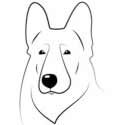Canine Degenerative Myelopathy
What is Canine Degenerative Myelopathy?
CDM is a disease of the spinal cord which casuses progrressive paralysis. Initially described in 1973, a gene has recently been discovered that that identifies dogs at risk.
It can almost be compared to Multiple Sclerosis in humans. It is an inflammatory spinal cord disease that disintegrates the myelin sheath which acts as insulation, protecting the nerve fibers in the spine.
Autoimmune Disease in Dogs
In German Shepherds, it is unique as it is considered dog autoimmune disease. The immune system attacks the central nervous system which leads to a loss of the myelin. Without these nerve connections, the muscles cannot work properly and the dog is unable to walk.
Other dog breeds that can develop the same type of DM as seen in the GSD are:
- Belgian Sheepdog
- Chesapeake Bay Retriever
- Great Pyrenees
- Laboratory Retriever
- Old English Sheepdog
- Rhodesian Ridgeback
- Weimeraner
It is unknown whether the exact condition exists in other dog breeds.
What Causes It?
DM appears to have genetic factors. Since it appears relatively frequently in GSD's, there is a supposed genetic predisposition.
Symptoms of Spinal Cord Diseases
Usually occurring in dogs aged 8-14 years, signs of spinal myelopathy can initially be difficult to spot. It is gradual in its progression. It usually starts with loss of coordination (ataxia) in the hind egs. Any combination of the following symptoms can appear, possibly disappear, only to reemerge:
- difficulty in rising or laying down
- dragging of rear legs
- hoarse bark
- knuckling (walking with toes bent under)
- limp tail
- loss of balance
- muscle wasting (usually as loss of rear musculature)
- rear legs crossing
- spinal ataxia
- stumbling
- weakness in the hindquarters
In its final stages, it leads to paralysis and incontinence.
Diagnosis of CDM is done by a matter of elmimination as the only way to confirm its presence is a microscopic examination of the spinal cord performed at an autopsy. Conditions that need to be eliminated include herniated disks, cysts, tumors, infections, injuries, tumors and stroke.
Treatment for Diseases of the Spinal Cord
Conventional medicine offers nothing for DM.
Roger Clemmons, DVM, Ph.D., Associate Professor of Neurology & Neurosurgery, Small Animal Clinical Sciences, at the University of Florida, has been researching canine degenerative myelopathy for most of his career. He has come up with a four step program to slow the progression of canine degenerative myelopathy.
It consists of:
- dietary supplementation
- exercise
- medication
- other supportive measures
Using his method, one German Shepherd owner was able to increase the quality of her dog's life and extend it from the 2-3 months she was given to 13 months.
Another German Shepherd's struggle with this disease can be found here. Read Noel's story of degenerative myelopathy.






